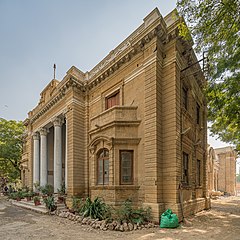Freemasons Lodge Building (Karachi)
Freemasons Lodge Building in Karachi, Pakistan is a historic building built in 1914, during British rule, situated near D.J. Sindh Govt. Science College at Molana Din Muhammad Wafai Road.
| Freemasons Lodge Building | |
|---|---|
 | |
| General information | |
| Architectural style | Colonial era |
| Location | Karachi, Pakistan |
| Country | Pakistan |
| Current tenants | Sindh Wildlife Department |
| Inaugurated | 1914 |
| Client | Pakistan government |
| Owner | Pakistan government |
The Freemasons Lodge was built by the Freemason's Trust in 1914, and was made of yellow sandstone.[1] It was used for many years for meetings of the Freemason Society. Local people called it "jadoo ghar," meaning "House of Sorcery."[2][3][4]
The building was taken over by the government after Freemasonry was banned in Pakistan in 1972 under the rule of President Zulfiqar Ali Bhutto.[5] In the early 1990s it was allocated to the Sindh Wildlife Department,[6] and it is now used by the Sindh Wildlife Fund.[7] Around 2001, it was declared a protected heritage site under the Sindh Cultural Heritage Act of 1994.[6] As of early 2009, renovations and preservation activity were underway, with plans to use part of the building as a museum.[2]
References
- The Herald. Pakistan Herald Publications. 1991. p. 102.
- Amar Guriro (January 4, 2009). "Renovation of the historical Freemason Lodge initiated". Daily Times (Pakistan).
- Peerzada Salman, Masonic mystique, Dawn.com, Sunday, 13 Dec, 2009
- Handbook of Freemasonry. BRILL. 2014-06-12. p. 251. ISBN 978-90-04-27312-2.
- Salman, Peerzada (2009-12-13). "Masonic mystique". DAWN.COM. Retrieved 2020-08-13.
- Amar Guriro, Culture department takes notice of Freemason Lodge Building , Daily Times (Pakistan), Tuesday, September 30, 2008
- Somaya, Brinda; Mehta, Urvashi (2000). An Emancipated Place: The Proceedings of the Conference and Exhibition Held in Mumbai, February 2000 : Women in Architecture, 2000 Plus : a Conference on the Work of Women Architects : Focus South Asia. Hecar Foundation. ISBN 978-81-7525-194-6.